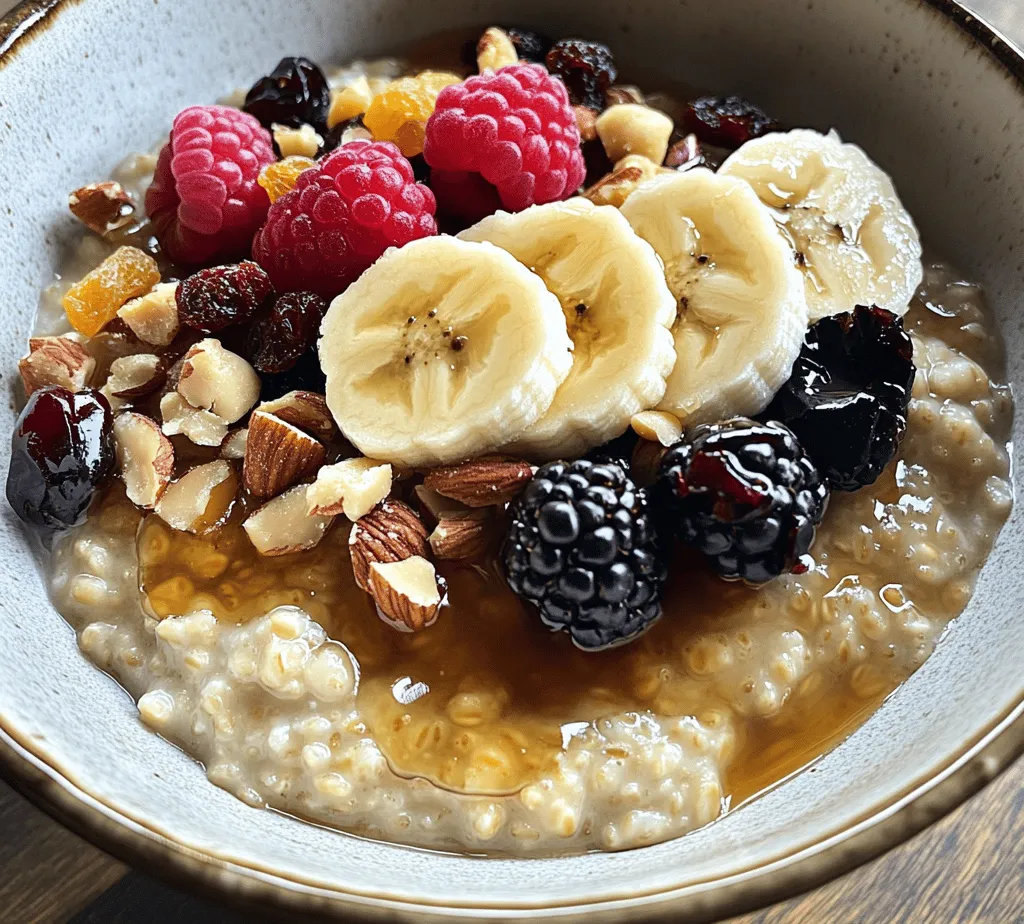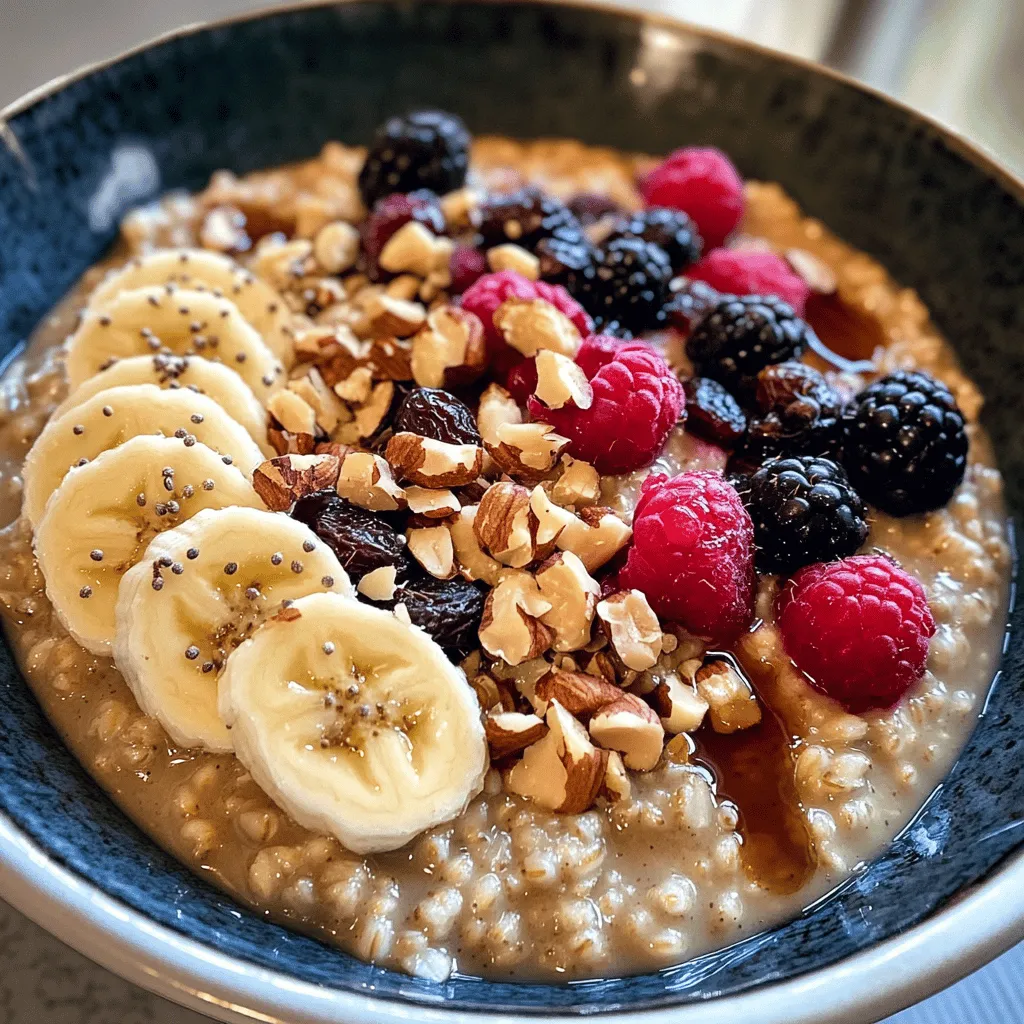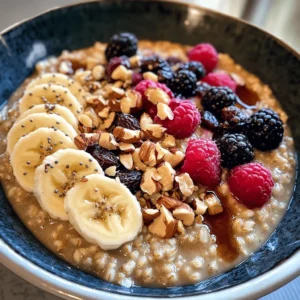Introduction
In recent years, barley has surged in popularity not just as a staple grain but as a nutritional powerhouse that elevates the breakfast experience. Once overshadowed by other grains, barley is now celebrated for its health benefits and versatility in the kitchen. Among the many delightful ways to enjoy this ancient grain, Creamy Barley Porridge Delight stands out as a wholesome and comforting breakfast option.
This recipe is not only easy to prepare but also customizable, making it an ideal choice for busy mornings. With its creamy texture and rich flavor, barley porridge is a dish that appeals to both children and adults. As a breakfast option, it provides sustained energy throughout the day, thanks to its high fiber content and low glycemic index. Whether you’re looking to nourish your body or simply enjoy a warm meal, this porridge is a fantastic way to kickstart your day.
Barley is packed with essential nutrients, including vitamins, minerals, and antioxidants that support overall health. Research has shown that incorporating barley into your diet may lower cholesterol levels, improve digestion, and help manage weight. With such compelling health benefits, it’s no wonder that barley is making a comeback on breakfast menus worldwide.
Understanding Barley: A Nutritional Powerhouse
Barley is a cereal grain that has been cultivated for thousands of years, making it one of the oldest cultivated grains in the world. Its versatility makes it suitable for various culinary applications, from soups and stews to salads and baked goods. But what truly sets barley apart is its impressive nutritional profile.
Nutritional Profile of Barley
Barley is rich in essential nutrients, including:
– Fiber: Barley is exceptionally high in soluble and insoluble fiber, with one cup of cooked barley containing approximately 6 grams of fiber. This fiber content plays a vital role in promoting digestive health, helping to regulate blood sugar levels, and keeping you feeling full longer.
– Vitamins and Minerals: Barley is a good source of several important vitamins and minerals, including B vitamins (such as niacin, thiamin, and riboflavin), iron, magnesium, phosphorus, and selenium.
– Low Glycemic Index: Barley has a low glycemic index (GI), meaning it releases glucose slowly into the bloodstream. This characteristic is particularly beneficial for individuals managing diabetes or those looking to maintain steady energy levels throughout the day.
Pearl Barley vs. Other Types of Barley
When it comes to choosing the right type of barley for your porridge, you may encounter several different varieties. The most common types are hulled barley, pearl barley, and barley flakes.
– Hulled Barley: This is the most nutritious form, as it retains the bran layer and germ. However, it has a longer cooking time and a chewier texture.
– Pearl Barley: Pearl barley is the most widely available type in grocery stores. It has been polished to remove the bran, resulting in a softer texture and shorter cooking time, making it perfect for porridge.
– Barley Flakes: These are similar to oatmeal and cook very quickly, but they may lack some of the nutrients found in hulled or pearl barley.
For this recipe, we recommend using pearl barley, as it strikes the perfect balance between nutrition and convenience.
Fiber Content and Its Benefits
The high fiber content in barley offers numerous health benefits, particularly for digestion and heart health. Soluble fiber can help lower LDL (bad) cholesterol levels by binding to bile acids in the intestine and promoting their excretion. Additionally, the insoluble fiber in barley aids in regular bowel movements and supports a healthy digestive tract.
Moreover, incorporating fiber-rich foods like barley into your diet can help maintain a healthy weight. High-fiber meals tend to be more filling, reducing the likelihood of overeating later in the day. This makes barley an excellent choice for anyone looking to improve their diet or achieve specific health goals.
Ingredients Breakdown
Now that we understand the nutritional benefits of barley, let’s take a closer look at the ingredients that make up the Creamy Barley Porridge Delight. Each component plays a crucial role, not only in enhancing the flavor and texture of the dish but also in contributing to its overall health benefits.
Pearl Barley: Characteristics and Cooking Properties
Pearl barley is a type of barley that has been polished to remove its bran layer, resulting in a softer grain that cooks more quickly than hulled barley. It has a mild, nutty flavor and a creamy texture when cooked, making it an ideal base for porridge. When purchasing pearl barley, look for grains that are free from any discoloration or debris.
Water or Low-Sodium Vegetable Broth
Liquid is essential for cooking barley, and you have the option to use either water or low-sodium vegetable broth. Using broth adds an extra layer of flavor to the porridge and enhances its overall taste profile. Opting for low-sodium broth ensures that you can control the sodium content in your meal, making it a healthier choice.
Milk (Dairy or Plant-Based)
To create the creamy texture that defines this porridge, milk is incorporated into the recipe. You can use either dairy milk or plant-based alternatives such as almond, soy, or oat milk. Each option brings its own unique flavor and nutritional benefits. Dairy milk is rich in calcium and protein, while plant-based milks often contain fewer calories and may be fortified with additional vitamins and minerals.
Sweeteners: Choosing Between Maple Syrup and Honey
To add a touch of sweetness to your porridge, you have the option to choose between maple syrup and honey. Maple syrup is a natural sweetener derived from the sap of maple trees, while honey is produced by bees. Both options provide distinct flavors and health benefits. Maple syrup contains antioxidants and has a lower glycemic index compared to refined sugar, making it a preferred choice for many. Honey, on the other hand, has antibacterial properties and can also soothe a sore throat.
Spices: The Role of Cinnamon
Cinnamon is a key spice in this recipe, adding warmth and depth of flavor. Beyond its delightful taste, cinnamon is known for its health benefits. It has anti-inflammatory properties and may help lower blood sugar levels, making it a beneficial addition to your breakfast. Sprinkle it generously over your porridge to enhance both its flavor and health benefits.
Fresh Fruits and Nuts: Contributions to Texture, Flavor, and Nutrition
To finish off your Creamy Barley Porridge Delight, fresh fruits and nuts are essential. They not only add texture and flavor but also boost the nutritional profile of the dish. Berries, bananas, and apples are excellent choices, providing vitamins, antioxidants, and a natural sweetness. Nuts such as almonds, walnuts, or pecans add healthy fats and protein, making your porridge a well-rounded meal.
Step-by-Step Instructions for Perfect Porridge
Now that we have a clear understanding of the ingredients and their benefits, it’s time to dive into the preparation of the Creamy Barley Porridge Delight. Follow these step-by-step instructions to create a delicious and nutritious breakfast that will leave you feeling satisfied and energized.
Rinsing the Barley: Importance and Technique
Before cooking pearl barley, it’s essential to rinse it thoroughly. Rinsing helps remove any dust or impurities and ensures that the grains are clean. To rinse the barley, place it in a fine-mesh sieve and run cold water over it for a few minutes. Swirl the grains gently with your hands to ensure they are well rinsed. Once the water runs clear, you can proceed to the cooking process.
Cooking the Barley: Achieving the Right Texture and Consistency
To cook the rinsed barley, you will want to combine it with water or low-sodium vegetable broth in a pot. The general ratio is 1 cup of barley to 3 cups of liquid. Bring the mixture to a boil over medium-high heat, then reduce the heat to low and cover the pot. Let the barley simmer for about 30-40 minutes or until it becomes tender and has absorbed most of the liquid.
Stir occasionally to prevent sticking and ensure even cooking. If you prefer a creamier texture, you can adjust the liquid amount, adding more broth or milk towards the end of cooking to achieve your desired consistency.




